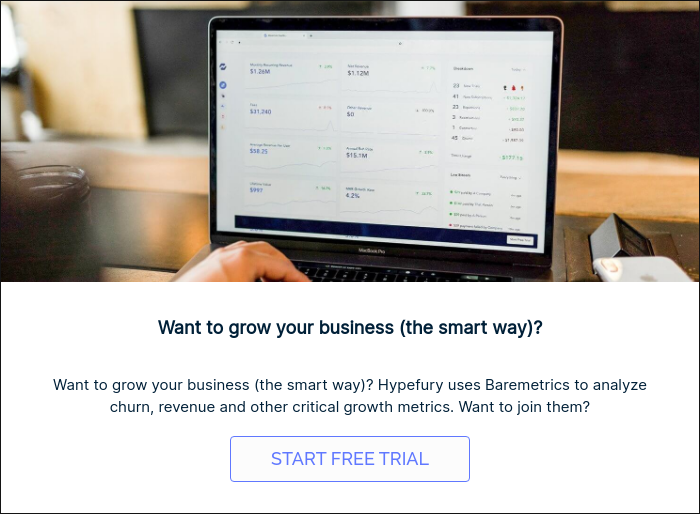Table of Contents
Startups can use financial modeling to predict their future financial performance and thus make smart strategic decisions based on projected revenue impact. Since startups are often focused on rapid growth and aggressive client acquisition while typically facing tight budgets, accurate financial models can be invaluable.
Fortunately, there are tools that can help with this. Forecast+ by Baremetrics, for example, is a financial modeling tool tailored for startups, offering financial modeling, forecasting, and scenario planning.
Let’s discuss everything you need to know about financial modeling software for startups and subscription businesses, including why you need it, key components of financial models, creating a financial model template, and how Forecast+ can help.
The Need for a Financial Model in Startups
Financial models and forecasts analyze your existing and historical revenue metrics, trends, and performance to predict future revenue.
Some forecast tools (including Forecast+) also offer scenario planning, which allows businesses to create plans and models based on things that might happen. Examples may include a recession, or if there’s disruption somewhere in your supply chain.
In times like those, these tools are invaluable.
Importance of Financial Planning
Financial planning involves looking at a business’s current performance, short-term goals, and long-term goals and deciding what to do to reach those goals.
This is important for all businesses, but it’s crucial for startups, as they have less room for error. Financial planning can allow for careful cash and time management, allowing startups to make the most of their limited resources.
Scenario planning models can also help develop strategic planning and risk management assessments, allowing your business to prepare for a number of potential futures.
Benefits of an Accurate Financial Model
There are several key benefits of accurate financial models:
- Enhanced decision-making based on realistic financial projections, allowing startups to allocate resources in ways that increase the likelihood of long-term business and revenue growth
- Ability to attract investors with clear and compelling financial forecasts
- Improved budget management and allocation of resources, which can include reducing cash flow problems
Types of Financial Models
There are multiple types of financial models startups can create. These are the most common models for startups:
- Discount cash flow (DCF) model. Uses discounted cash flow forecasting to determine a company’s present value.
- Three-statement model. Forecasts a company’s income statement, balance sheet, and cash flow statement.
- Input-Output (IPO) model. Identifies a business’s inputs, outputs, and necessary tasks to transform the former into the latter.
- Consolidation model. Combines the financial results of multiple businesses into a single unit.
- Budget model. Used to determine the allocation of resources based on business objectives, strategic initiatives, and business needs.
- Leveraged buyout model. Often used to evaluate the acquisition of a company funded using debt.
Key Components of a Financial Model for Startups
Financial models involve multiple components. Remember— the more accurate and thorough the data you add to the model, the more accurate and impactful the projections will be.
- Revenue Projections, which provide estimates for future sales based on market analysis and historical data.
- Cost Structures, which offer a detailed breakdown of fixed and variable costs, making it easy for you to understand how scaling up or down impacts costs.
- Cash Flow Analysis, which monitors liquidity and cash reserves to ensure operational stability
- Profit and Loss Statement, which is a periodic assessment of financial health through income, expenses, and net profits
- Break-even Analysis, which calculates the point at which total revenues equal total costs
Creating a Financial Model Template
Creating a startup financial model template typically involves using an Excel spreadsheet, though you can use dedicated tools like Forecast+.
Let’s look at how to streamline the process with Forecast+.
When creating financial model templates, you’ll need to do the following:
- Determine which type of financial model you want to create
- Collect data, using only reliable data sources; verifying the accuracy of the data if you haven’t already
- Creating the template, either making your own in an Excel sheet or using tools like Forecast+
- Add key financial components to the model
- Make ongoing updates and adjustments as needed to account for new data and changing conditions
1. Gathering Data
Each data model takes multiple metrics and KPIs into account. The specific information you need varies from model to model.
Baremetrics’ MRR projections will help you forecast your monthly recurring revenue up to 12 months out. To do so, we’ll need your current MRR, growth type, average revenue growth, and revenue churn. (Good news: We automatically input most of this data for you since it’s already part of our revenue analytics reporting software).
We cannot stress enough how important it is to ensure you’re using reliable data sources for forecasting. Some subscription revenue tools, for example, inadvertently reflect inaccurate MRR by assuming all “active” subscriptions result in revenue. In reality, they may be paused or delinquent on payment.
And since you’re already using Baremetrics, you’re in good hands. Learn more about our accurate subscription metrics.
2. Creating Your Operating Model
Building templates for financial models can be complicated. For reference, Baremetrics has a free financial model template to get you started, using sample data to give you an idea of how it looks.
When using Forecast+, you’ll be asked to connect to Quickbooks or Xero. The data pulled from these platforms— combined with the data sources already integrated into Baremetrics— will be essential for automatically generating financial models, which you can review at any point.
3. Incorporating Components
Many financial models need components beyond KPIs like MRR. Examples include balance sheets, profit and loss (P&L) statements, and cash flow statements.
When using Forecast+, you’ll be able to use data that’s already been synched to the platform. You can import all of the reports above directly from Quickbooks or Xero. (If we don’t yet offer an integration for a platform you use, you can request it!)
Baremetrics’ Operating Model contains your P&L, cash flow, and balance sheet statements. It displays actuals side-by-side, showing you what’s actually happened. You can compare this to forecasted estimates or scenario planning data.
You can also create and edit scenarios (including baseline, best-case, and worst-case projections) and budgets for improved financial planning.
4. Iterative Refinement
Businesses change. That’s true for all brands, but it’s particularly accurate for startups with rapid growth and evolution.
As a result, you don’t want to make a single set of financial models and hang up your hat. It’s important to check in regularly, making updates and adjustments based on new data, changing conditions, and even new potential scenarios.
Forecast+ makes this incredibly easy. It’s a modular financial modeling platform, so you can change different factors (like considering linear growth vs. exponential growth). See how small— or large!— changes impact your business over time.
You can also export financial models at any point. Just click on the “Export” tab in the Forecast+ section, and you can download the current models.
Conclusion
Robust financial models for startups can be invaluable, helping you plan for multiple scenarios, significantly improve cash flow, and make smarter decisions to scale up customer and revenue growth.
Manually creating financial models is complex, time-consuming, and prone to human error. Leveraging Baremetrics’ Forecast+ allows you to create financial models with simplified input.
Our models are all easy to adapt, allowing you to see how changes in the market or business performance can impact your revenue long-term.
FAQ's
-
What are the different types of financial models that startups can use?
Startups can use various financial models including forecasting models, budgeting models, valuation models, and scenario planning models. -
What are some key components to include in a financial model for startups?
Revenue projections, expense forecasts, cash flow statements, and balance sheets. -
How can financial modeling benefit startups and small businesses?
Financial modeling benefits startups by providing insights into cash flow, helping with fundraising, and enabling strategic planning and decision-making. -
What are some common challenges when developing a startup financial model?
Common challenges in developing a startup financial model include accurately predicting future revenues, managing variable expenses, and accounting for market uncertainties. -
How frequently should a startup update or revise its financial model?
Startups should update or revise their financial model at least quarterly or whenever there are significant changes in their business or market conditions.




